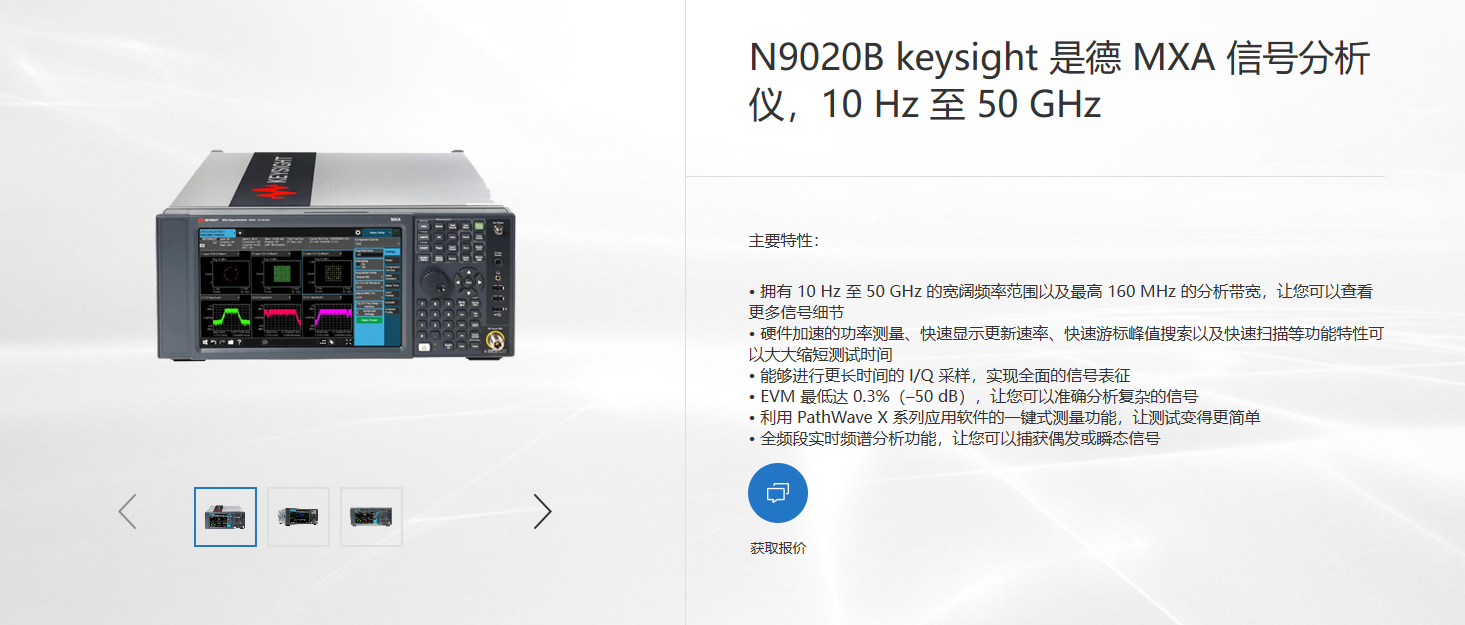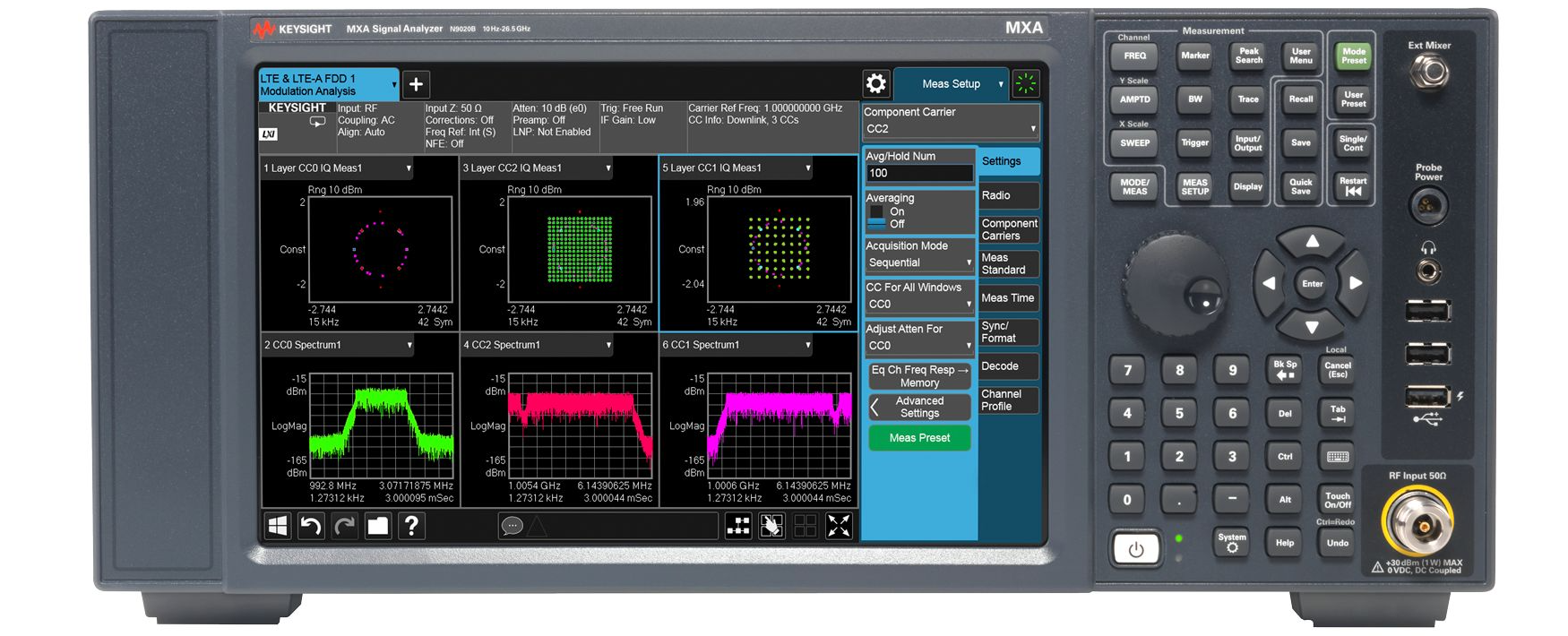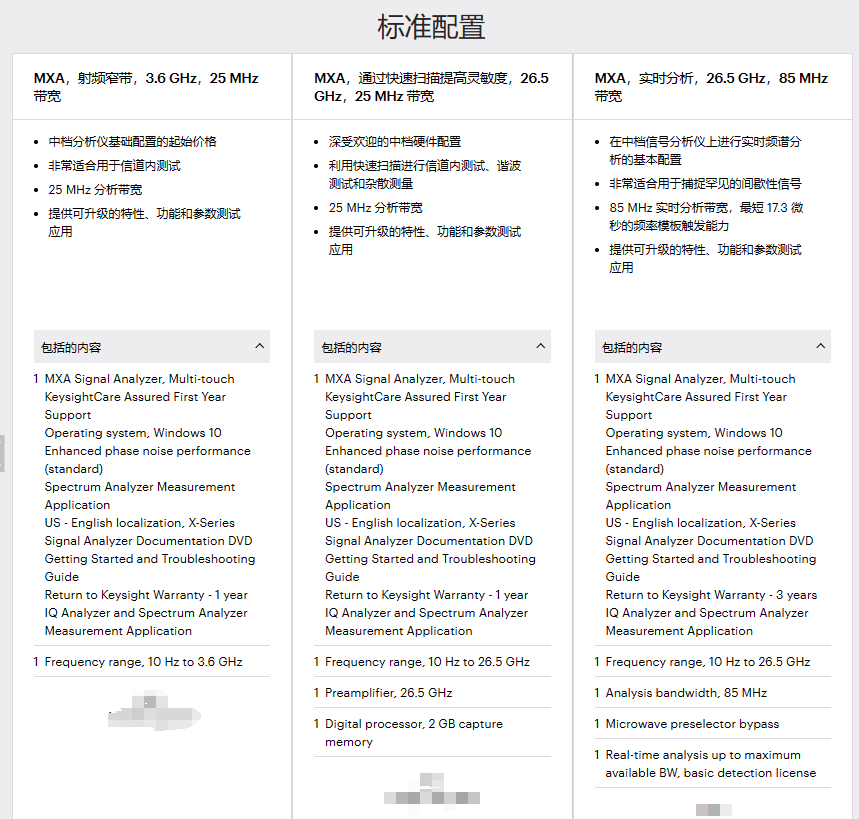N9020B keysight signal analyser Short Description
The N9020B is a Keysight signal analyser, part of the X-Series family. With a frequency range from 10 Hz to 20 GHz and an analysis bandwidth of up to 130 MHz, it features a multi-touch interface that significantly reduces measurement complexity, even when testing more advanced devices.
Frequency range: from 10 Hz to 20 GHz for testing a wide range of wireless devices.
Analysis bandwidth: up to 130 MHz, ensuring high-precision signal analysis.
Phase noise: Less than -114 dBc/Hz at 10 kHz offset.
Dynamic range: Third-order dynamic range exceeds 116 dB.
Hardware-accelerated power measurements: Reduce test time with hardware-accelerated power measurements, fast display updates and marker peak searches, and fast sweeps.
Multi-touch interface: Simplifies the operation process and improves the user experience.
The N9020B also supports a variety of options and accessories that can be upgraded as needed. For example, users can choose from different frequency ranges (e.g., 26.5 GHz or 50 GHz) and analysis bandwidths (e.g., 60 MHz or higher), as well as enhanced phase noise performance.
The N9020B is a powerful signal analyser for a wide range of wireless device testing needs, featuring a high frequency range, high analysis bandwidth and an advanced user interface.

How does the N9020B Signal Analyser compare to similar products such as the Agilent E444A or Tektronix FFTs in terms of performance and price?
Performance Comparison
Frequency range:
The N9020B signal analyser has a frequency range of 10 Hz to 20 GHz.
Tektronix's MDO4000 series supports RF bands up to 3/6 GHz, but this is in the 100 MHz to 1 GHz range.
Dynamic Range:
Tektronix's MDO4000 series has about 15 dB better dynamic range.
With hardware-accelerated power measurements, the N9020B signal analyser quickly adapts to the evolving test requirements of wireless devices and features cursor peak search and fast scanning.
Real-time spectrum analysis:
The N9020B signal analyser can be upgraded to add real-time spectrum analysis without recalibration.
Tektronix's MSO46 4-BW-200 mixed-signal oscilloscope, while including a maths-based FFT, is less capable of optimising views between the frequency and time domains.
Functional Features:
Designed for testing wireless devices, the N9020B offers the latest in parametric and RF functional testing.
Tektronix's MDO4000 series independently controls the time and frequency domains, providing an optimised view that is not possible with conventional oscilloscope FFTs.
What are some of the user feedback and reviews of the Keysight Technologies N9020B Signal Analyser, especially in real-world applications?
Flexibility and Adaptability: The N9020B MXA Signal Analyser is considered an excellent choice in the wireless space, with excellent flexibility to quickly adapt to users' changing test requirements, both current and future. This demonstrates the unit's ability to meet diverse testing needs and to cope with future technological developments.
The design enhances the user experience and makes the device easier to use.
Balance of high and medium performance: The N9020B MXA is described as a medium-performance signal analyser, but it is still one of the best options on the market. This means it strikes a good balance between performance and price for those who need high performance but don't want to spend too much.
Simplified test flow: The device supports a one-button measurement function that simplifies the test flow from within the X-Series application. This simplified operation significantly improves test efficiency and reduces the user's workload.
This wide frequency range enables the device to handle a variety of signals from low to high frequencies.
What specific hardware-accelerated power measurement techniques does the N9020B Signal Analyser support, and what are the principles and benefits of these techniques?
Principle
Hardware-accelerated power measurement technology focuses on power measurement by means of specialised hardware modules, thus reducing the computational burden and increasing the measurement speed. This technique utilises a high-performance Digital Signal Processor (DSP) and Fast Fourier transform (FFT) algorithms to process the signal data, allowing complex power measurement tasks to be completed in a short period of time.
Advantages
Reduced test time: Hardware acceleration significantly reduces the time required for measurements, making the test process more efficient.
Fast display updates: Hardware acceleration enables fast updates of the data on the display, allowing the user to monitor the measurement results in real time and adjust the test parameters in a timely manner.
Marked Peak Search: The technology also includes a Marked Peak Search function, which automatically identifies and marks important signal peaks, further improving the accuracy and efficiency of the test.
Fast Scan: Hardware acceleration also supports the Fast Scan function, which scans the entire spectrum in a very short period of time to capture hard-to-capture transients or weak signals.

How to Configure and Optimise Keysight Technologies N9020B Signal Analyser to Improve Test Efficiency and Accuracy
Hardware Upgrade:
Select the appropriate analysis bandwidth upgrade option as needed. For example, Option B85 upgrades the analysis bandwidth from 25 MHz to 35 MHz, while Option B1A can upgrade it to 145 MHz.
If external mixing capability is required, Option EXM can be installed, which includes the necessary licences, cables and connectors.
Performance Options and Measurement Applications:
Determine the desired performance options and measurement applications.The N9020B MXA X-Series Signal Analyser offers a wide range of performance options and measurement applications that can be selected based on specific needs.
Consider adding the Noise Floor Extension (N9020B-NF2) to improve the analyser's DANL (Detection Noise plus System Noise) performance.
Hardware and software configuration:
Ensure that the device has a high-performance processor, sufficient RAM (e.g., 32 GB), and flash calibration file storage to support complex measurement tasks.
Use the Microsoft Windows 10 operating system and ensure that the device has a multilingual user interface.
Hardware check and verification:
On the device, press the ‘System’ menu, select ‘Show Hardware’, and record the part number, material version, version number, factory version, and hardware ID of the front-end controller.
If the unit has the N9010B-CR3, N9010B-CRP, N9020B-CR3 and/or N9020B-CRP installed, follow steps 3 and 4 for further configuration.
Additional features and services:
Add real-time spectrum analysis capabilities as needed to more quickly adapt to the evolving test needs of wireless devices.
Consider purchasing a recommended external duplexer (e.g., Keysight N9029AE13 or OML Inc.'s DPL313B), especially when using Keysight 11970 series external mixers.
The N9020B is a Keysight signal analyser, part of the X-Series family. With a frequency range from 10 Hz to 20 GHz and an analysis bandwidth of up to 130 MHz, it features a multi-touch interface that significantly reduces measurement complexity, even when testing more advanced devices.
Frequency range: from 10 Hz to 20 GHz for testing a wide range of wireless devices.
Analysis bandwidth: up to 130 MHz, ensuring high-precision signal analysis.
Phase noise: Less than -114 dBc/Hz at 10 kHz offset.
Dynamic range: Third-order dynamic range exceeds 116 dB.
Hardware-accelerated power measurements: Reduce test time with hardware-accelerated power measurements, fast display updates and marker peak searches, and fast sweeps.
Multi-touch interface: Simplifies the operation process and improves the user experience.
The N9020B also supports a variety of options and accessories that can be upgraded as needed. For example, users can choose from different frequency ranges (e.g., 26.5 GHz or 50 GHz) and analysis bandwidths (e.g., 60 MHz or higher), as well as enhanced phase noise performance.
The N9020B is a powerful signal analyser for a wide range of wireless device testing needs, featuring a high frequency range, high analysis bandwidth and an advanced user interface.

How does the N9020B Signal Analyser compare to similar products such as the Agilent E444A or Tektronix FFTs in terms of performance and price?
Performance Comparison
Frequency range:
The N9020B signal analyser has a frequency range of 10 Hz to 20 GHz.
Tektronix's MDO4000 series supports RF bands up to 3/6 GHz, but this is in the 100 MHz to 1 GHz range.
Dynamic Range:
Tektronix's MDO4000 series has about 15 dB better dynamic range.
With hardware-accelerated power measurements, the N9020B signal analyser quickly adapts to the evolving test requirements of wireless devices and features cursor peak search and fast scanning.
Real-time spectrum analysis:
The N9020B signal analyser can be upgraded to add real-time spectrum analysis without recalibration.
Tektronix's MSO46 4-BW-200 mixed-signal oscilloscope, while including a maths-based FFT, is less capable of optimising views between the frequency and time domains.
Functional Features:
Designed for testing wireless devices, the N9020B offers the latest in parametric and RF functional testing.
Tektronix's MDO4000 series independently controls the time and frequency domains, providing an optimised view that is not possible with conventional oscilloscope FFTs.
What are some of the user feedback and reviews of the Keysight Technologies N9020B Signal Analyser, especially in real-world applications?
Flexibility and Adaptability: The N9020B MXA Signal Analyser is considered an excellent choice in the wireless space, with excellent flexibility to quickly adapt to users' changing test requirements, both current and future. This demonstrates the unit's ability to meet diverse testing needs and to cope with future technological developments.
The design enhances the user experience and makes the device easier to use.
Balance of high and medium performance: The N9020B MXA is described as a medium-performance signal analyser, but it is still one of the best options on the market. This means it strikes a good balance between performance and price for those who need high performance but don't want to spend too much.
Simplified test flow: The device supports a one-button measurement function that simplifies the test flow from within the X-Series application. This simplified operation significantly improves test efficiency and reduces the user's workload.
This wide frequency range enables the device to handle a variety of signals from low to high frequencies.
What specific hardware-accelerated power measurement techniques does the N9020B Signal Analyser support, and what are the principles and benefits of these techniques?
Principle
Hardware-accelerated power measurement technology focuses on power measurement by means of specialised hardware modules, thus reducing the computational burden and increasing the measurement speed. This technique utilises a high-performance Digital Signal Processor (DSP) and Fast Fourier transform (FFT) algorithms to process the signal data, allowing complex power measurement tasks to be completed in a short period of time.
Advantages
Reduced test time: Hardware acceleration significantly reduces the time required for measurements, making the test process more efficient.
Fast display updates: Hardware acceleration enables fast updates of the data on the display, allowing the user to monitor the measurement results in real time and adjust the test parameters in a timely manner.
Marked Peak Search: The technology also includes a Marked Peak Search function, which automatically identifies and marks important signal peaks, further improving the accuracy and efficiency of the test.
Fast Scan: Hardware acceleration also supports the Fast Scan function, which scans the entire spectrum in a very short period of time to capture hard-to-capture transients or weak signals.

How to Configure and Optimise Keysight Technologies N9020B Signal Analyser to Improve Test Efficiency and Accuracy
Hardware Upgrade:
Select the appropriate analysis bandwidth upgrade option as needed. For example, Option B85 upgrades the analysis bandwidth from 25 MHz to 35 MHz, while Option B1A can upgrade it to 145 MHz.
If external mixing capability is required, Option EXM can be installed, which includes the necessary licences, cables and connectors.
Performance Options and Measurement Applications:
Determine the desired performance options and measurement applications.The N9020B MXA X-Series Signal Analyser offers a wide range of performance options and measurement applications that can be selected based on specific needs.
Consider adding the Noise Floor Extension (N9020B-NF2) to improve the analyser's DANL (Detection Noise plus System Noise) performance.
Hardware and software configuration:
Ensure that the device has a high-performance processor, sufficient RAM (e.g., 32 GB), and flash calibration file storage to support complex measurement tasks.
Use the Microsoft Windows 10 operating system and ensure that the device has a multilingual user interface.
Hardware check and verification:
On the device, press the ‘System’ menu, select ‘Show Hardware’, and record the part number, material version, version number, factory version, and hardware ID of the front-end controller.
If the unit has the N9010B-CR3, N9010B-CRP, N9020B-CR3 and/or N9020B-CRP installed, follow steps 3 and 4 for further configuration.
Additional features and services:
Add real-time spectrum analysis capabilities as needed to more quickly adapt to the evolving test needs of wireless devices.
Consider purchasing a recommended external duplexer (e.g., Keysight N9029AE13 or OML Inc.'s DPL313B), especially when using Keysight 11970 series external mixers.








